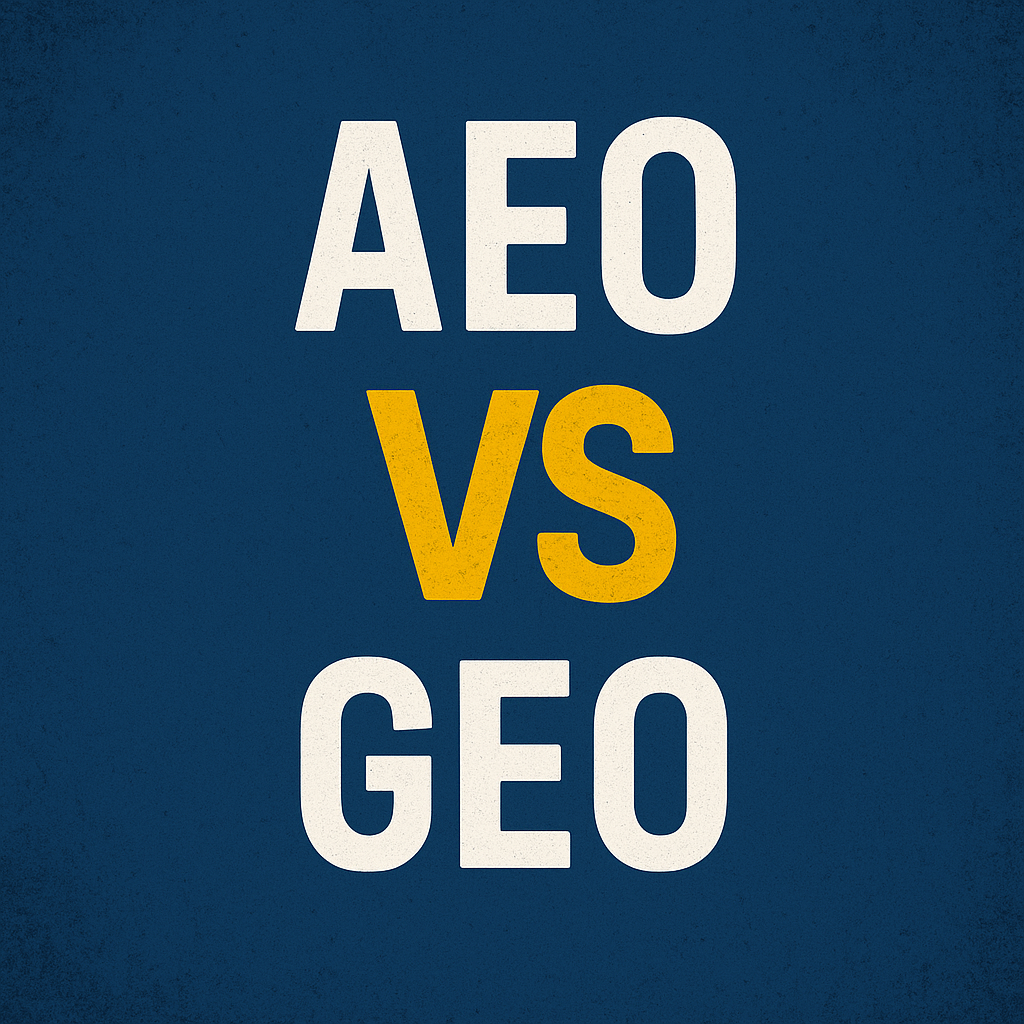AEO vs GEO: Why SEO Is Not Dead
Search is changing faster than ever. Artificial intelligence has reshaped how people find information, but contrary to the headlines, SEO is not dead. Instead, it has evolved into two distinct but complementary strategies: AEO (Answer Engine Optimization) and GEO (Generative Engine Optimization). Understanding the difference between these two is crucial for anyone serious about maintaining visibility in both traditional search and the new AI-driven world.
What Is AEO (Answer Engine Optimization)?
AEO is the practice of optimizing content so that it can be pulled directly into answer boxes, featured snippets, and voice assistants. The rise of mobile search and smart speakers made this approach necessary, and it remains one of the most powerful tactics for capturing high-intent traffic.
Key elements of AEO include:
FAQ-driven content: Writing in a Q&A style that mirrors how users phrase queries.
Schema markup: Adding structured data so search engines can clearly interpret the meaning of your content.
Featured snippet targeting: Formatting answers in short, direct blocks of text.
Conversational tone: Anticipating natural language queries such as “How do I…?” or “What is the best…?”
When executed correctly, AEO makes your content the one Google, Siri, or Alexa uses when providing a spoken or highlighted answer.
What Is GEO (Generative Engine Optimization)?
Generative Engine Optimization (GEO) is the response to the rise of AI-driven search engines like Google’s Search Generative Experience (SGE), Bing Chat, and ChatGPT. These platforms no longer simply rank pages, they generate summarized responses and often cite or recommend sources directly within the search interface.
Optimizing for GEO means:
Chunk-level content design: Creating sections that can be easily extracted by AI models.
Authoritative, clear statements: Writing content that AI can quote confidently.
Entity coverage: Building topical depth so your content aligns with the semantic relationships AI systems rely on.
Trust signals: Reinforcing credibility through backlinks, structured data, and brand authority so your site is preferred as a source.
In short, GEO ensures your brand isn’t left out when AI systems summarize answers for users.
Key Differences Between AEO and GEO
While both share the same DNA, their applications differ:
AEO = Answer-first SEO → Aimed at featured snippets, voice search, and FAQ-based results.
GEO = AI-first SEO → Aimed at visibility inside generative responses from AI-driven search.
AEO satisfies searcher intent quickly with concise answers.
GEO ensures your content is trusted and cited by AI systems, even when the AI writes the “answer” itself.
AEO emerged pre-AI, when search was keyword- and snippet-driven.
GEO is the evolution, designed for AI-enhanced platforms like Google SGE.
Both are necessary. AEO keeps you strong in traditional search. GEO makes you future-ready.
Why SEO Isn’t Dead
Every few years, claims that “SEO is dead” make the rounds. The truth is different: SEO is more alive and more necessary than ever.
Here’s why:
AI still needs data. Generative engines like ChatGPT and Google SGE don’t invent authority. They rely on crawling, indexing, and citing from websites. Without optimized, authoritative content, they have nothing reliable to summarize.
Visibility now happens in more places. Ten years ago, search results were “10 blue links.” Today, answers appear in snippets, map packs, video carousels, People Also Ask boxes, and now AI-generated summaries. SEO is the engine that powers every one of these placements.
User trust is built on brands, not bots. AI can generate text, but users want to know who the source is. GEO and AEO make sure your brand is recognized, trusted, and cited.
Click-through opportunities remain. Even if AI answers some questions directly, users still click through when they need detail, services, or purchases. SEO ensures you’re the one capturing those clicks.
Simply put, SEO has not died, it has diversified.
Benefits of AEO
Featured snippets: Higher click-through rates from position zero.
Voice search optimization: Dominating “near me” and question-style queries.
Improved user experience: Clear, concise answers build trust and reduce bounce rates.
Authority signaling: Being the “go-to answer” elevates brand credibility.
Benefits of GEO
AI visibility: Your content appears inside Google SGE, Bing Chat, and ChatGPT answers.
Brand citations: Even if a user doesn’t click, your name becomes familiar.
Competitive moat: Few businesses are optimizing for GEO today, giving early adopters an edge.
Future-proofing: As generative engines evolve, your business stays ahead of the curve.
How to Implement Both
Build a strong SEO foundation: Technical health, fast load speeds, crawlable site architecture.
Add AEO layers: FAQs, schema, conversational content, and snippet-optimized answers.
Expand with GEO strategies: Create deeper topical clusters, focus on entities, and write authoritative content chunks designed for AI retrieval.
Track performance in both arenas: Monitor snippet rankings, FAQ impressions, and emerging visibility inside Google SGE and Bing Chat.
The Future of SEO
SEO has never been static. From keyword stuffing in the early 2000s, to the rise of link building, to mobile-first indexing, and now AI-driven search, the game has always changed. What hasn’t changed is the need for businesses to be found, trusted, and chosen.
AEO wins the now by securing featured snippets and voice search.
GEO wins the future by ensuring AI platforms recognize and cite your brand.
SEO ties it all together, proving it isn’t dead, it’s evolving.
417BOOM AEO/GEO Services
The businesses that succeed online will be the ones that adapt, not abandon. AEO and GEO aren’t replacements for SEO; they are its natural extensions. Traditional SEO gives you the foundation. AEO captures immediate answers. GEO secures your brand’s role in the AI-driven search landscape.
SEO is not dead. It’s transforming, and those who embrace AEO and GEO will thrive while everyone else struggles to keep up.











